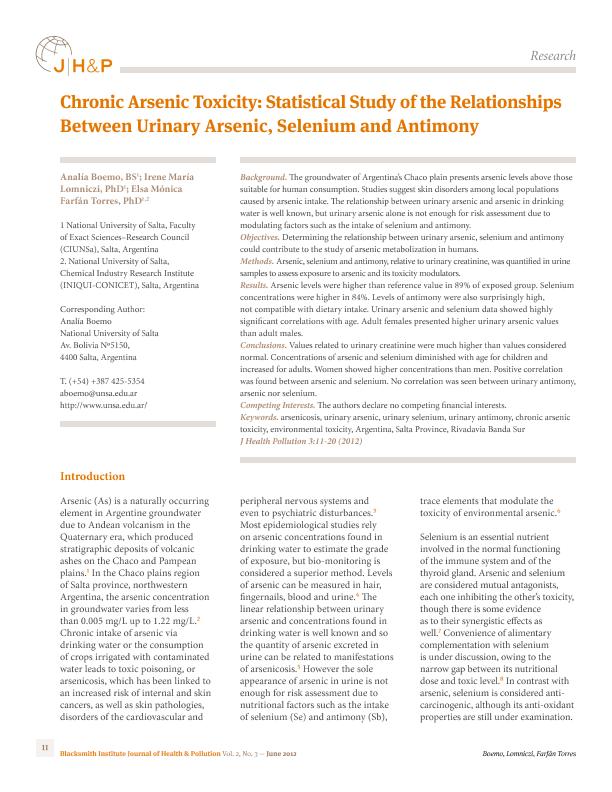Artículo
Chronic Arsenic Toxicity: Statistical Study of the Relationships Between Urinary Arsenic, Selenium and Antimony
Fecha de publicación:
06/2012
Editorial:
Blacksmith Institute
Revista:
Journal of Health and Pollution
ISSN:
2156-9614
Idioma:
Inglés
Tipo de recurso:
Artículo publicado
Clasificación temática:
Resumen
Background: The groundwater of Argentina’s Chaco plain presents arsenic levels above those suitable for human consumption. Studies suggest skin disorders among local populations caused by arsenic intake. The relationship between urinary arsenic and arsenic in drinking water is well known, but urinary arsenic alone is not enough for risk assessment due to modulating factors such as the intake of selenium and antimony. Objectives: Determining the relationship between urinary arsenic, selenium and antimony could contribute to the study of arsenic metabolization in humans. Methods: Arsenic, selenium and antimony, relative to urinary creatinine, was quantified in urine samples to assess exposure to arsenic and its toxicity modulators. Results: Arsenic levels were higher than reference value in 89% of exposed group. Selenium concentrations were higher in 84%. Levels of antimony were also surprisingly high, not compatible with dietary intake. Urinary arsenic and selenium data showed highly significant correlations with age. Adult females presented higher urinary arsenic values than adult males. Conclusions: Values related to urinary creatinine were much higher than values considered normal. Concentrations of arsenic and selenium diminished with age for children and increased for adults. Women showed higher concentrations than men. Positive correlation was found between arsenic and selenium. No correlation was seen between urinary antimony, arsenic nor selenium.
Archivos asociados
Licencia
Identificadores
Colecciones
Articulos(INIQUI)
Articulos de INST.DE INVEST.PARA LA INDUSTRIA QUIMICA (I)
Articulos de INST.DE INVEST.PARA LA INDUSTRIA QUIMICA (I)
Citación
Boemo, Analía; Lomniczi, Irene Maria; Farfan Torres, Elsa Monica; Chronic Arsenic Toxicity: Statistical Study of the Relationships Between Urinary Arsenic, Selenium and Antimony; Blacksmith Institute; Journal of Health and Pollution; 2; 3; 6-2012; 11-20
Compartir
Altmétricas




